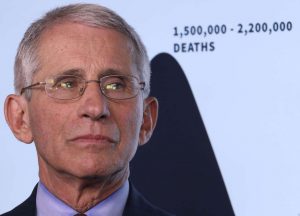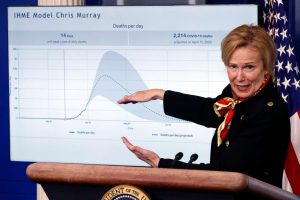APRIL 9, 2020

Dr. Anthony Fauci, director of the National Institute of Allergy and Infectious Diseases, participates in the daily coronavirus task force briefing in the Brady Briefing room at the White House on March 31, 2020 in Washington, DC. – Win McNamee, Getty Images
Senior White House adviser Anthony Fauci said Thursday the death toll from the coronavirus could be closer to 60,000 Americans, assuming full social distancing, rather than the previously projected 100,000 to 240,000 deaths.
“The real data are telling us that it is highly likely that we’re having a definite positive effect by this mitigation things that we’re doing – this physical separation – so I believe we are gonna see a downturn in that,” Fauci, the director of the National Institute of Allergy and Infectious Diseases, told NBC’s “Today” show.
“And it looks more like the 60,000 than the 100,000 to 200,000,” he said.
Fauci did not say which model he is using to come up with the estimate, but his comments came as a leading model from the University of Washington that experts in the White House have been using also predicted fewer Americans may die from coronavirus than previously thought.
That model now projects 60,415 people will die in the U.S. by Aug. 4, compared to previous projections that approached 100,000. Forty-five states and the District of Columbia will have fewer deaths than previously thought, under the model.
“A key CoronaVirus Model is now predicting far fewer deaths than the number shown in earlier models,” President Donald Trump said Thursday on Twitter. “That’s because the American people are doing a great job. Social Distancing etc. Keep going!”
But the model also shows five states with projected increases: Connecticut, Massachusetts, New Jersey, North Dakota and Rhode Island.
New Jersey is likely to see 5,277 deaths from coronavirus, compared to 2,117 previously estimated. The state also may not see a peak in deaths until April 12. The model previously predicted a peak in deaths on Thursday.
New Jersey Gov. Phil Murphy called the situation “an unprecedented crisis,” in a tweet Wednesday. The state, which was among the first to issue a stay-at-home order, is now coordinating with local and federal officials to set up field hospitals to treat the surge of patients.
“By following the facts on the ground and consulting closely with medical experts, we will break the back of the #COVID19 curve,” Murphy tweeted from his official Twitter account.
Changes to the University of Washington’s model reflect “a massive infusion of new data,” said Dr. Christopher Murray, director of the school’s Institute for Health Metrics and Evaluation. The university began its projections on March 26. To date, its model is the most comprehensive state-by-state rundown of the number of resources each state will need to combat the coronavirus.
After more than a week of new data, including peaks in seven locations in Spain and Italy, the impact of social distancing is “much clearer,” the University of Washington stated in a news release.
“It is unequivocally evident that social distancing can, when well implemented and maintained, control the epidemic, leading to declining death rates,” Murray said.
New health data from states such as New York, Massachusetts, Florida and Pennsylvania, for example, helped lead to some of the downward revisions.
But Massachusetts and Connecticut are both projected to see thousands more deaths than originally projected.
Massachusetts is now forecast to see 5,625 total deaths by early August – up from the 1,506 initially projected – with a peak on April 18. Connecticut is forecast to see 4,003 deaths, an increase of more than 3,500 over the original projection.
The University of Washington’s latest projections use averages to account for “variable data collection or reporting practices” from states.
Additionally, the numbers assume Americans practice full social distancing similar to what happened in China through May 2020.

Dr. Deborah Birx, White House coronavirus response coordinator, speaks about the coronavirus in the James Brady Press Briefing Room of the White House, Tuesday, March 31, 2020, in Washington. – Alex Brandon, AP
“We are making those forecasts based on the effects of social distancing and other mitigation efforts we saw in other countries – especially China,” Abraham Flaxman, a member of the team, told the science magazine Nautilus. “We are assuming it will happen here in much the same way.”
Not all Americans have heeded the guidelines. A few states, like Arkansas, have yet to enact strict stay-at-home orders. And even people in hard-hit states like New York continue to pack into the limited subway system to get to work or buy groceries.
“It’s pretty hard in New York to try to keep the social distancing,” said Bessie Liu, a New York University student who lives in Brooklyn.
Liu said she rode the train to get groceries two weeks ago, but there were too many other riders to maintain the 6-foot social distancing rule. She said she worried about exposure to the virus and ended up taking an Uber back home.
“It wasn’t packed,” she said, “but it was like you couldn’t keep 6 feet apart.”
In Ohio, where state officials were early to enact social distancing measures, the updated model projects 489 deaths, a decrease from an earlier projection of 1,671 deaths.
“You have squashed this and stretched this curve,” Ohio Gov. Mike DeWine tweeted on Wednesday. “But please know that if you start going out, we’ll go right back up. You have to keep doing what you’re doing.”
Murray cautioned the evidence shows that social distancing is crucial and that trajectories could still change for the worse.
“Those nations hit hard early on implemented social distancing orders and may have the worst behind them as they are seeing important progress in reducing their death rates,” Murray stated.”
Any lifting of the measures could push the epidemic to go longer, Murray told the USA TODAY Network in late March. Trajectories could change for the worse if people ease up on social distancing or relax precautions.
“We know now for sure that the mitigation we’ve been doing is having a positive effect, but you don’t see it until weeks later,” Fauci said Wednesday in the daily White House briefing. “Those efforts need to continue. We know that this is something that is a strain on the American public, but it’s just something that we have – not only the only tool, it’s the best tool.”
Courtesy/Source: This article originally appeared on USA TODAY










































































































